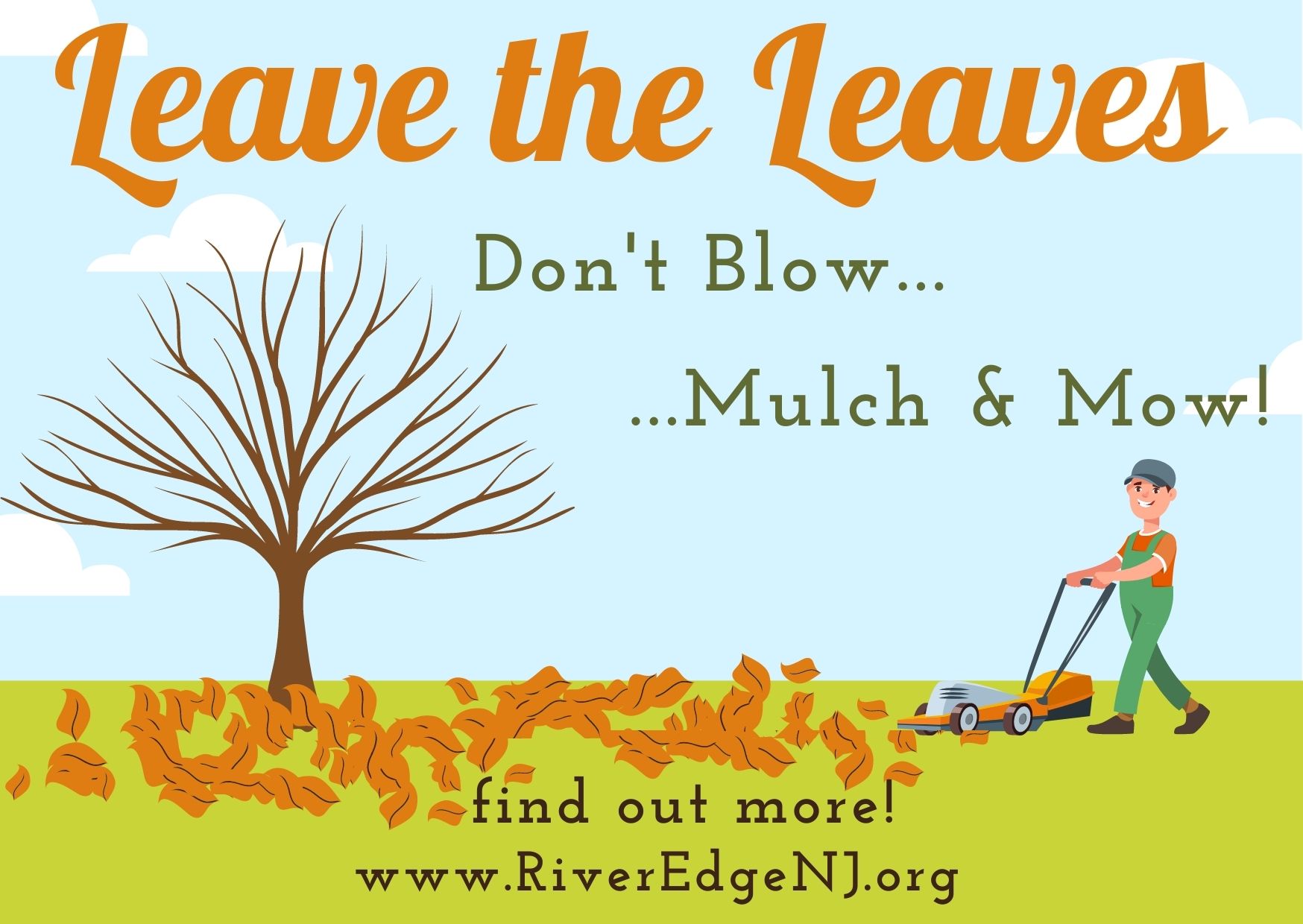Leave The Leaves

Leave the Leaves
A program encouraging residents to mow & mulch leaves back into their lawn
The Shade Tree Commission, Environmental Commission, and Green Team
invite you to
Join the “Don’t Blow, Mulch & Mow” Challenge
Pick a section of your yard to mow the leaves.
After you are comfortable, increase the size. You can then start to rake leaves from the planting beds into the lawn to mulch them in.
If leaf mulch is excessive in the lawn it can be put back into the planting beds to create homemade mulch.
Tell your landscapers to mow the grass and leaves into the lawn
See below for information on how to start...
How natural mulch works:
The forest naturally breaks down leaves and plant material during the winter months. Birds and other animals walk on and under fallen leaves constantly moving and breaking them down while the rain and snow breaks down the pieces further. Your mower acts as the agent to reduce the leaf size, allowing rain, snow, and microorganisms to break them down creating home-made mulch. By the time spring comes, new plants use this nutrient rich mulch to grow.
The leaf mulch acts as a protective layer in the winter. During the growing season the mulch prevents weed growth and helps to conserve water. Leaf mulch decomposes over time adding important nutrients and structure to the soil.
Reasons why to leave the leaves:
- Saves money - No further need to fertilize the lawn and planting beds. Grass & leaf clippings are natural fertilizers, providing nitrogen to the soil
- Saves time - Less time and money spent on raking & blowing leaves
- Better Health – Improves air quality by reducing allergens in the air letting you breath easier
- Reduces pollution - Keeps leave from going into sewers
- Quieter neighborhoods – Reduces noise pollution
- More available space on streets – Frees up parking & driving area on our streets and is safer for driving
- Saves the town money – Minimizes waste disposal costs while cutting down on time spent picking up leaf piles off the street
- Encourages biodiversity – Leaves are an important source for overwintering beneficial insects and butterflies, which also leads to a more varied bird population.
Myths about mulching leaves that prevent residents from mowing leaves:
- Leaf mulch will be messy
- Neighbors might complain
- Increase population of unwanted bugs and other pests
- Hired landscaper may not do it for you
- Special equipment will be needed
VIDEO: Click here to see how nature uses leaves
How To Mulch Leaves:
- Mulch-mowing can be done by using a mower without the bag or by using a leaf shredder. Depending on the type of mower blade, you may need to pass over the leaf pile several times. Mulched leaves can then be left on in a thin layer on your lawn or they can be placed in a 3-4” layer on garden beds and around shrub and trees.
- You can also dedicate a small area of your yard to a free-form leaf compost area. Pile leaves in the area and let nature take care of them. In 2-3 years the leaves will turn into mulch.
- Rake the leaves from hardscapes (driveways and patios) onto the lawn and mow them into the lawn. Or mow them on the hardscape surface and move the mulched leaves back onto garden beds or the lawn. Lawn sweepers are also a good alternative to remove leaf litter, twigs, and acorns from hardscape surfaces and lawns.
VIDEO: Click here to see how Mulch & Mow works
Mulching leaves on perennial beds:
Blowing leaves out of landscaped beds, around shrubs and tree roots, removes valuable nutrients and is destructive to topsoil. To add leaf mulch in perennial flower beds, rake excessive leaves from between plants and shrubs, pile them in rows between the plants and then mow the rows. The volume is reduced and the leaves will gradually turn into compost, enriching the soil. There is no need to remove leaves from ground covers like pachysandra. You can gently rake over the plants so that the leaves fall under the plants to the ground. The leaves will naturally decompose over the winter.
Free Seedlings grown Naturally
By leaving a small area of your yard free from mowing altogether, you will create your own tree nursery. Small saplings of native trees will appear and grow giving you a new, low-cost, no-maintenance tree! Because the tree grew naturally in a place that was favorable for optimal health and survival, the tree will require little care. It can take 2-3 years for a sapling to grow.
- Pick an area of your yard where you want a tree to grow and mark it off with stakes or a garden fence.
- Make sure to compensate for the size the tree will be when it is mature. Typically keeping 20-30ft from houses, fences, pathways is a good rule of thumb.
- Leave the area alone and patiently wait.
- As saplings grow, leave them for 2-3 years, and then pick one of the trees to continue to grow, removing the others by pruning them to the ground. Or you can gently dig extra saplings and transplanting to another area of your property or give to a friend.
Please remember: Don’t dump leaves, branches, or other garden waste into the woods or parks
Click and Print Document from NJDEP: Grass Cut It and Leave It.pdf
.jpg)
Click here to find out more about planting trees for River Edge
.jpg)
TREE NEWS
_______________________________________________________________________________________________________________________________________
Free Tree Seedlings - Typically offered on Arbor Day which is the last Friday in April. Pick up locations are the River Edge Library and Cherry Blossom Park (adjacent to Cherry Hill School. ) Seedlings are offered yearly during Arbor Day Weekend on a first come, first serve basis outside of the pickup locations until supplies are gone. Residents can pick up the seedlings anytime. These barefoot seedlings are being given by the River Edge Shade Tree Commission and were obtained through the NJ Tree Recovery Program. Residents are encouraged to replace trees on their property and should be planted within a week of picking up.
Arbor Day is celebrated yearly in River Edge on the last Friday of April at the Elementary Schools. Be sure to thank our DPW Tree Crew, STC Volunteers, and Mayor & Council for their care & support of our communities trees. Thank you to all residents for keeping River Edge green!
_______________________________________________________________________________________________________________________________________
Emerald Ash Borer (EAB) was discovered in New Jersey in May 2014 in Somerset County. Infestations throughout the U.S. and Canada have killed tens of millions of ash trees since 2002. As of August 2016, emerald ash borer has been found in New Jersey in Bergen, Burlington, Essex, Hunterdon, Mercer, Middlesex, Monmouth and Somerset counties. This non-native insect kills ash trees by laying eggs under the bark. when the larvae hatch, they burrow under the bark and feed on the cambium - the water and nutrient transporting layer of the tree.
In 2017 the DPW Tree Crew found evidence of the borer in River Edge. It was decided to have the Borough trees treated to help prevent the destruction of our 400+ Street and Park ash trees. If you have questions or have an ash tree on your property, please consult with a licensed tree professional for further guidance. The treatment was repeated in 2019.
Visit the NJ Dept of Agriculture EAB page for more information on the EAB and how to identify ash trees and the EAB.
Spotted Lanternfly: has been seen in our area. This pest is not typically destructive to trees, but can damage other plants and herbs. For more information visit: Stomp It Out Spotted Lanternfly NJ
_______________________________________________________________________________________________________________________________________
Tree Inventory in our Parks: The Commission volunteers completed a tree inventory and tagging in Memorial Park.
Memorial Park contains 341 trees being tagged. Older trees were predominantly native species of oak, maple, elm and a few shagbark hickory. New plantings include sycamore, sweet gum, birch, willow and replacements of the natives that have been lost.
_______________________________________________________________________________________________________________________________________
Space Shuttle Pine "Dr. Smith": The River Edge Shade Tree Commission was the recipient of a “Space Shuttle White Pine” which was given out in a raffle at the New Jersey Shade Tree Federation’s Annual Meeting in October 2010. The seedling, one of 36 raffled, was grown from seeds that traveled aboard the United States Space Shuttle Columbia in April 4, 1997 on mission STS-83. The Demarest Shade Tree Commission requested that NJ native, Astronaut Gregory T. Linteris, PhD be given the seed germination kits to take on board. The flight was cut short, landing only 4 days later, yet the seeds traveled 17,500 mph for a distance of 1.5 million miles. When the seeds returned to earth, they were germinated at a greenhouse in Jackson, NJ by the NJ Community Forestry Service as part of the Heritage Tree Program. The normal germination rate for Eastern White Pine seeds is 10-14 day, however, the space seeds germinated in half that time.
The tree location is now listed with the NJ State Department of Environmental Protection and will be placed on their list of historically significant trees in 10 years.
The RE Shade Tree Commission planted the white pine in the town arboretum behind the library and nicknamed it “Dr. Smith” based on the character from the 1960’s TV show Lost in Space.
